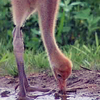Eastern Flock Chicks: Hatch Year 2007 |
|||||||||||||||
| 2005 | 2006 | 2007 | 2008 | 2009 | 2010 | 2011 | 2012 | 2013 | 2014 | 2015 | 2016 | ||||
Group
1 |
||||
Learn
to migrate Group 1 chicks are captive-born.
|
|
|
||
|
|
|
|
|
|
|
|
||
|
|
|
|
Photos: WCEP |
Group
2 |
|||||||||||||||
|
|||||||||||||||
| Group 3 | |||
Learn to migrate by following their parents Group 3 chicks are wild-born. Their parents raise them and teach them to migrate. This is the natural way cranes learn to migrate. One day, the flock will be large enough for wild-born parents to take over and human assisted migration will no longer be needed. Scientists hope to reach their goal of 125 birds by 2020. |
Zero wild-born chicks hatched in summer 2007. | ||




























